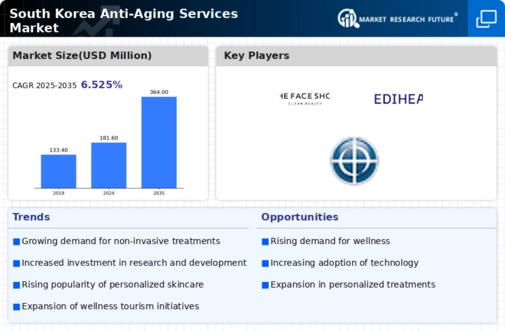Rising Disposable Income
The economic landscape in South Korea has shown a steady increase in disposable income, which plays a crucial role in the growth of the anti aging-services market. As individuals have more financial resources at their disposal, they are more inclined to invest in personal care and wellness services. Reports indicate that the average disposable income has risen by approximately 5% annually over the past few years, allowing consumers to prioritize spending on anti aging treatments. This trend suggests that as financial stability improves, more individuals are likely to seek out premium services, including advanced skincare treatments and cosmetic procedures. The anti aging-services market is thus positioned to benefit from this economic growth, as consumers increasingly view these services as essential rather than luxury expenditures.
Increasing Aging Population
The demographic shift towards an older population in South Korea is a primary driver of the anti aging-services market. As life expectancy continues to rise, the demand for services that address age-related concerns is likely to increase. In 2025, approximately 20% of the population is projected to be over 65 years old, creating a substantial market for anti aging solutions. This trend indicates a growing awareness among older adults regarding the importance of maintaining a youthful appearance and overall health. Consequently, businesses in the anti aging-services market are adapting their offerings to cater to this demographic, focusing on both aesthetic and health-related services. The increasing aging population not only drives demand but also encourages innovation in service delivery, as providers seek to meet the unique needs of older clients.
Cultural Emphasis on Youthfulness
In South Korea, there exists a strong cultural emphasis on youthfulness and beauty, which significantly influences the anti aging-services market. The societal norms that prioritize a youthful appearance drive individuals to seek various treatments and services aimed at maintaining or enhancing their looks. This cultural perspective is reflected in the high demand for skincare products and cosmetic procedures, with the market experiencing growth rates of around 10% annually. The desire to conform to beauty standards fosters a competitive environment among service providers, leading to the introduction of innovative treatments and personalized services. As the anti aging-services market continues to evolve, it is likely that cultural factors will remain a pivotal driver, shaping consumer preferences and influencing service offerings.
Advancements in Medical Technology
Technological advancements in the medical field are transforming the anti aging-services market in South Korea. Innovations such as laser treatments, regenerative medicine, and minimally invasive procedures are becoming increasingly accessible and popular among consumers. These advancements not only enhance the effectiveness of treatments but also reduce recovery times, making them more appealing to a broader audience. The market is witnessing a surge in the adoption of these technologies, with a projected growth rate of 8% in the coming years. As consumers become more informed about the benefits of these advanced treatments, the demand for high-quality anti aging services is expected to rise. This trend indicates that the integration of cutting-edge technology will continue to play a vital role in shaping the future of the anti aging-services market.
Growing Awareness of Health and Wellness
There is a notable increase in awareness regarding health and wellness among South Korean consumers, which is significantly impacting the anti aging-services market. As individuals become more conscious of the link between overall health and appearance, they are increasingly seeking services that promote both aesthetic and health benefits. This trend is reflected in the rising popularity of holistic approaches that combine skincare with wellness practices, such as nutrition and fitness. The anti aging-services market is adapting to this shift by offering integrated services that address both beauty and health concerns. With an estimated growth rate of 7% in wellness-related services, it appears that the market is evolving to meet the demands of a more health-conscious consumer base, indicating a potential for sustained growth in the coming years.














Leave a Comment